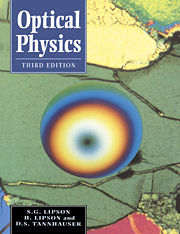Book contents
- Frontmatter
- Contents
- Preface to the third edition
- Preface to the second edition
- Preface to the first edition
- 1 History of ideas
- 2 Waves
- 3 Geometrical optics
- 4 Fourier theory
- 5 Electromagnetic waves
- 6 Polarization and anisotropic media
- 7 Diffraction
- 8 Fraunhofer diffraction and interference
- 9 Interferometry
- 10 Optical waveguides and modulated media
- 11 Coherence
- 12 Image formation
- 13 The classical theory of dispersion
- 14 Quantum optics and lasers
- 15 Problems
- Appendix 1 Bessel functions in wave optics
- Appendix 2 Lecture demonstrations in Fourier optics
- Bibliography
- Index
Preface to the second edition
- Frontmatter
- Contents
- Preface to the third edition
- Preface to the second edition
- Preface to the first edition
- 1 History of ideas
- 2 Waves
- 3 Geometrical optics
- 4 Fourier theory
- 5 Electromagnetic waves
- 6 Polarization and anisotropic media
- 7 Diffraction
- 8 Fraunhofer diffraction and interference
- 9 Interferometry
- 10 Optical waveguides and modulated media
- 11 Coherence
- 12 Image formation
- 13 The classical theory of dispersion
- 14 Quantum optics and lasers
- 15 Problems
- Appendix 1 Bessel functions in wave optics
- Appendix 2 Lecture demonstrations in Fourier optics
- Bibliography
- Index
Summary
Since the writing of the first edition the subject of Optics, as studied in universities, has grown greatly both in popularity and scope, and both we and the publishers thought that the time had arrived for a new edition of Optical Physics.
In preparing the new edition we have made substantial changes in several directions. First, we have attempted to correct all the mistakes and misconceptions that have been pointed out to us during the nine years the book has been in use. Secondly, we have made one important change in the subject matter: we have absorbed the chapter on Quantum Optics into the rest of the book. During the years, there have appeared many books devoted to laser physics, and it now seems impracticable for a book on physical optics to cover the subject at all satisfactorily in one chapter. However, since some knowledge of the principles of the laser is necessary for the understanding of physical optics today, particularly when coherence is being discussed, we have covered what we feel to be the necessary minimum as parts of Chapters 7 and 8.
In addition to the above changes in the subject matter, we have increased the number of exercises offered to the reader, organized them according to chapter, and provided solutions. We have also included a few suggestions, based on our experience, for student projects illustrating the material in the book.
We are, of course, most grateful to all those who have pointed out to us errors and room for improvement.
- Type
- Chapter
- Information
- Optical Physics , pp. xv - xviPublisher: Cambridge University PressPrint publication year: 1995



